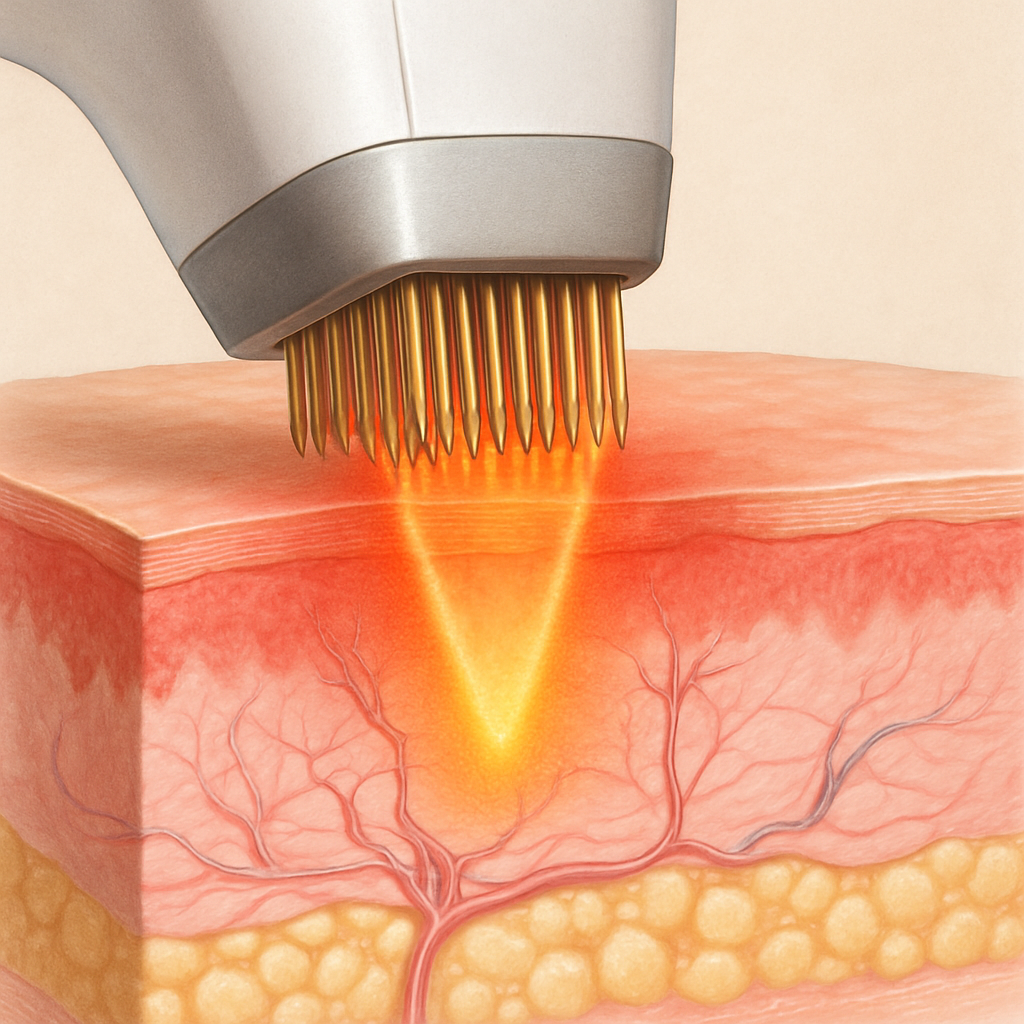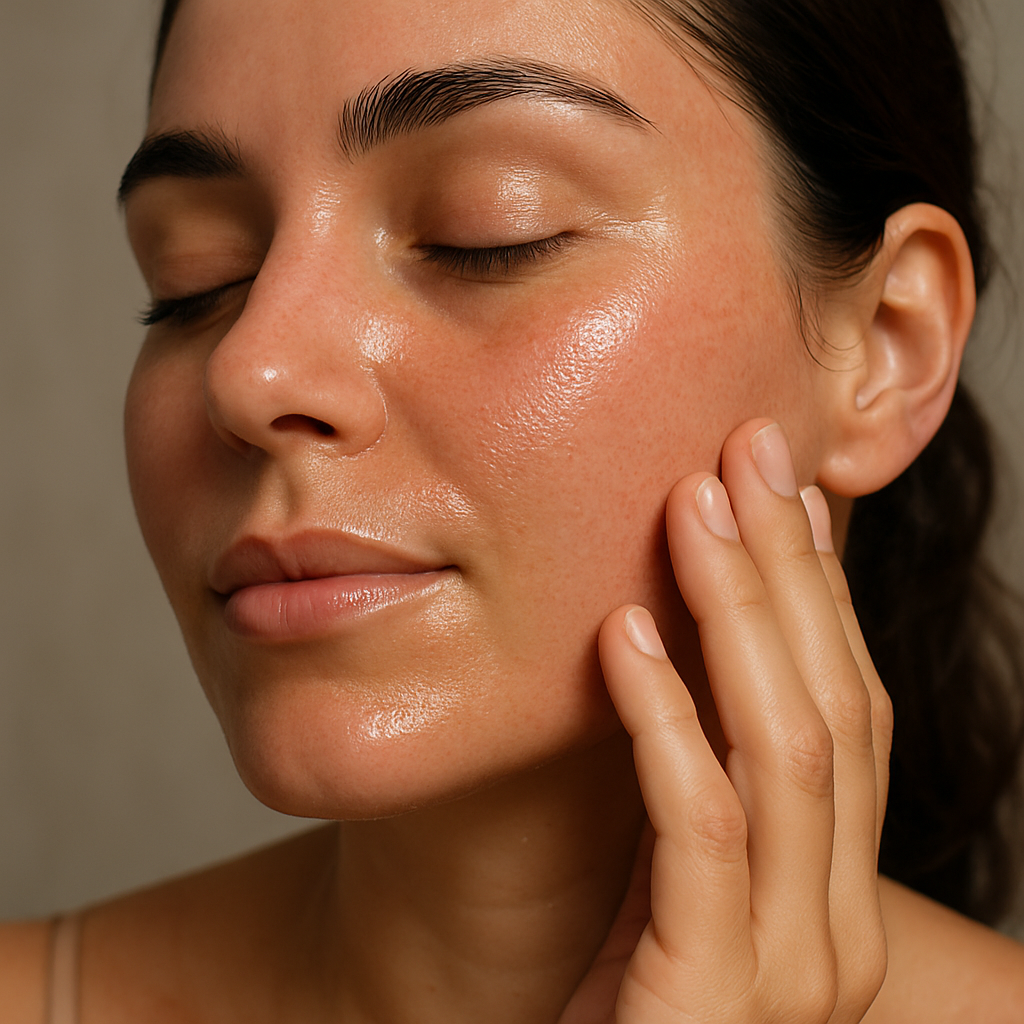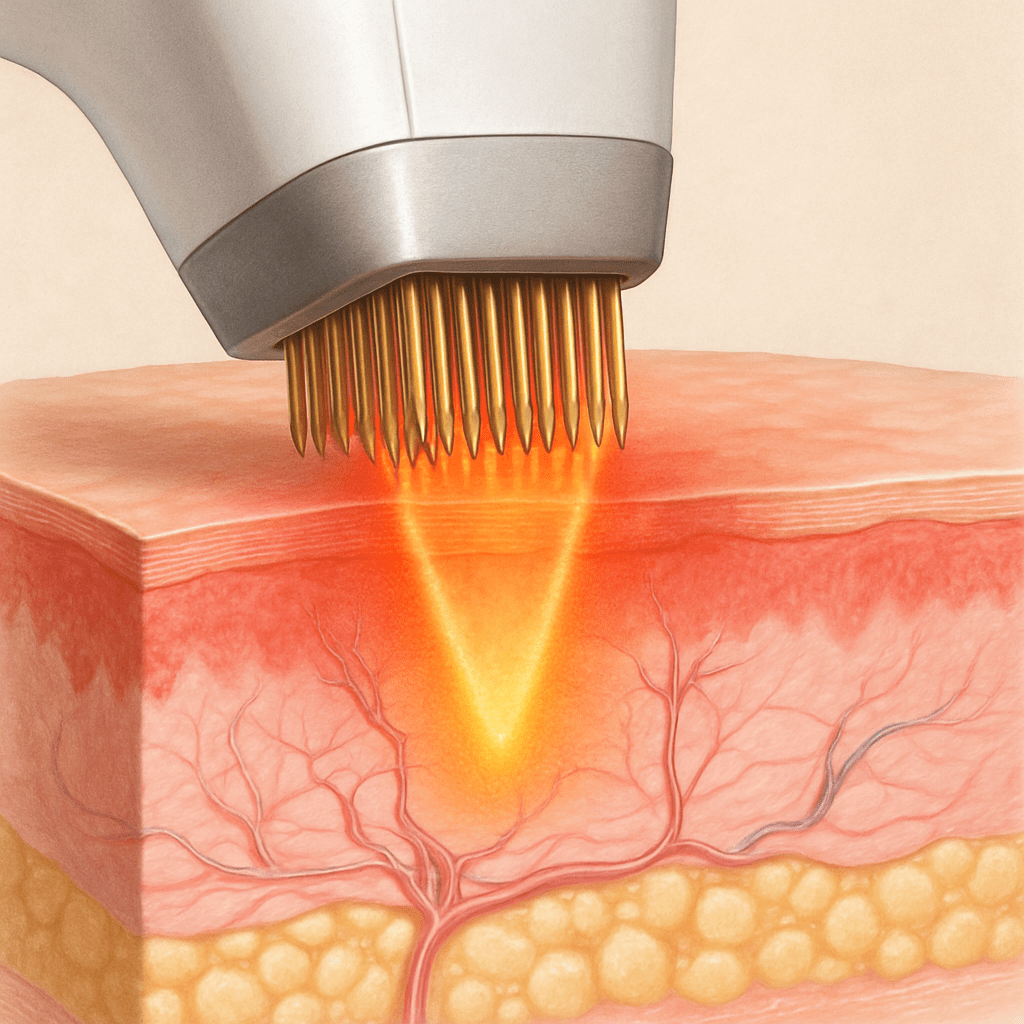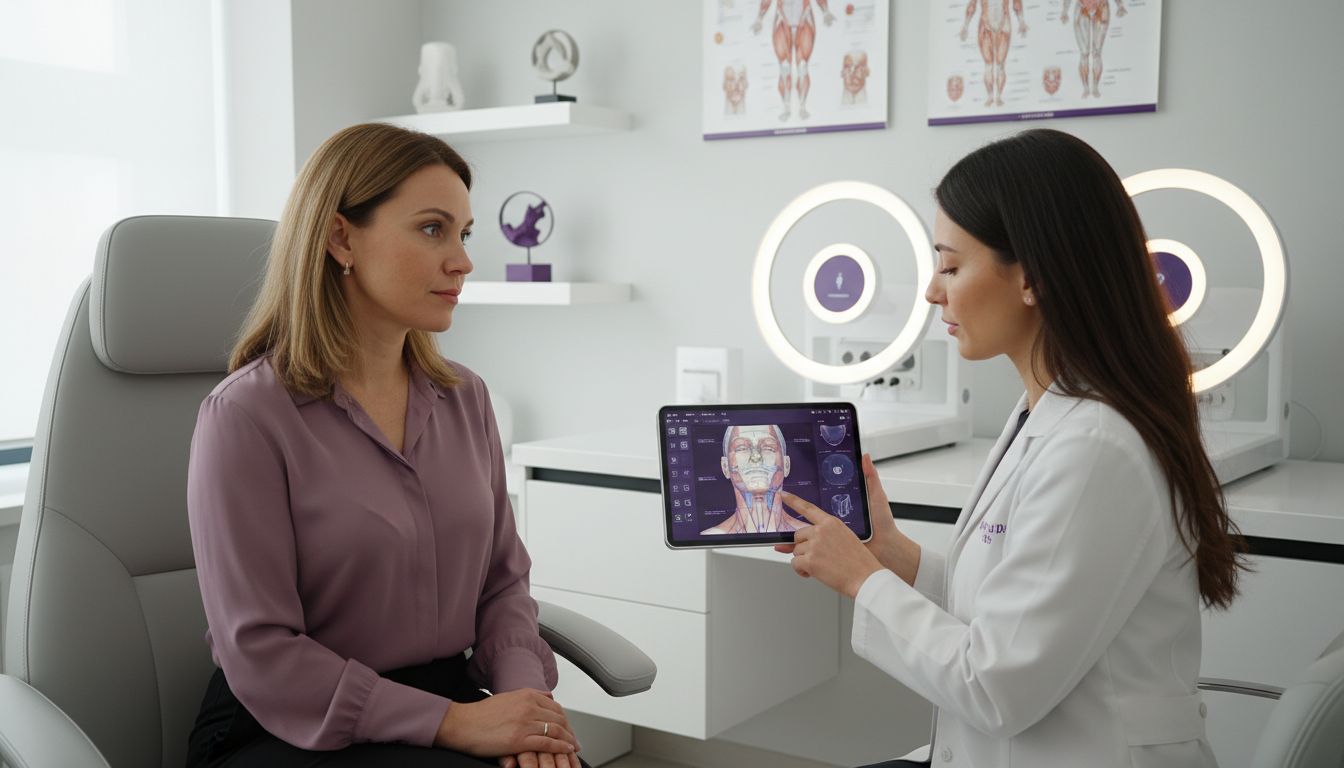Ever thought about diving into RF microneedling but got stuck on one nagging question: what are the side effects? You’re not alone. It’s that moment where you want to glow up, yet worry about what might come after the treatment. We get it—nobody wants to trade a wrinkle for a rash or unexpected downtime.
RF microneedling combines tiny needles with radiofrequency energy to boost collagen and tighten skin. It’s kind of like an intense workout for your face cells—but like any workout, there may be some soreness or unexpected results. So, what should you really expect?
Most people notice some redness or mild swelling right after the procedure—think of it like a sunburn, only shorter-lived. Some might experience tiny pinpoint bleeding or slight bruising, especially if their skin is sensitive. These aren’t deal-breakers but more like your skin’s way of saying it’s waking up and working hard behind the scenes.
Now, have you heard of post-inflammatory hyperpigmentation? It sounds scary, but basically, that’s when the skin darkens temporarily at the treatment spots—usually in people with darker skin tones or those exposed to the sun too soon after the session. Which brings me to a crucial tip: sunscreen is your new best friend post-treatment.
Honestly, RF microneedling side effects usually clear up within a week or two. It’s rare, but some people might notice dryness, tightness, or mild irritation that calls for extra moisturizing and gentle care. The biggest secret? Choosing a trusted clinic with experienced professionals who tailor the procedure to your skin type and needs.
If you’re curious about how this treatment could fit your skin goals, check out unlock radiant skin with microneedling in Barrie—it’s full of insights that’ll help you feel confident and informed. And hey, while you’re at it, I stumbled upon an interesting read about how to use a heatless curling rod headband for beautiful, damage-free curls—because who says self-care isn’t also fun?
Let’s dive in and unpack the whole story behind RF microneedling side effects so you can go in feeling good—not worried.
TL;DR
RF microneedling side effects are usually mild and short-lived, like redness, dryness, or slight irritation.
Most clear up within a week or two, especially when you care for your skin gently and keep sunscreen handy. Choosing a skilled clinic really makes all the difference to avoid surprises.
How RF Microneedling Works and Why Side Effects Occur
Ever wondered why your skin gets that flushed, tender feeling right after an RF microneedling session? It’s kind of like when you push your limits at the gym—your skin’s tissues get a little stressed out on purpose, sparking a healing frenzy that ultimately leaves you looking fresher.
Here’s the thing: RF microneedling isn’t your everyday facial massage. It combines two powerful actions—tiny needles that poke the skin and radiofrequency waves that heat it beneath the surface. Together, they create controlled micro-injuries that quietly shout to your body, “Hey, repair time!”
What’s Actually Happening Beneath Your Skin?
Think of your skin like a garden. Over time, the soil gets compacted, and the plants—your collagen and elastin fibers—start wilting and sparse. Microneedling makes tiny holes in that soil, breaking it up and allowing fresh nutrients to flow in.
Now, add radiofrequency waves. These waves deliver gentle heat deep into the layers of skin, without burning the surface. This heat acts like a wake-up call to your skin cells—specifically the collagen-producing ones. They start cranking out new collagen and elastin, which work to smooth wrinkles, tighten fat pockets, and even out skin tone.
This combo is why RF microneedling can be a game-changer—stimulating your skin’s natural repair process while targeting deeper layers for better results than microneedling alone. As a side note, unlike some laser treatments, RF energy spares pigment cells near the surface, reducing risks of discoloration if you have darker skin tones (according to expert dermatology insights).
So, Why Do Side Effects Show Up?
Because we’re essentially triggering controlled “damage,” side effects are part of the package. It’s the skin’s natural response kicking in—redness, swelling, maybe some dryness or mild irritation. It’s like when you get a sunburn, but way less intense and temporary.
And here’s a key point: the needle punctures create tiny channels in your skin, which means temporary inflammation and repair processes are underway. This healing phase can make the treated area look and feel sensitive for a few days.
The heat from the radiofrequency adds to the mix by encouraging deeper tissue remodeling but can also contribute to swelling or a warm sensation. This isn’t dangerous if managed well, but if the energy level is too high or the device stays too long on one spot, it can lead to complications, like burns or prolonged redness (Cleveland Clinic points out the importance of experienced practitioners).
Does Everyone Experience Side Effects the Same Way?
Not exactly. Your skin type, sensitivity, and the skill of your clinician all factor in. We all heal differently—think of it like how some people get bruises easily, while others don’t.
Most side effects are mild and short-lived, lasting just a few days to a week. But if you notice anything like excessive swelling, blistering, or dark discoloration, that’s a sign to reach out to your provider immediately. These more serious reactions are rare but deserve attention.
Also, safety checks before your treatment are key. For example, if you have active skin infections or uncontrolled skin conditions, microneedling might not be the best move right now.
How Can You Keep Side Effects in Check?
It starts by choosing a trusted clinic—like Simcoe Cosmetic Clinic—where experienced pros tailor the treatment to your skin and know exactly how to balance energy levels and needle depths.
Post-care makes a huge difference, too. Gentle cleansing, hydrating your skin, and keeping out of the sun while it heals are your best bets. These simple steps help calm inflammation faster and reduce the risk of annoying side effects like dryness or pigmentation changes.
Quick reminder: while RF microneedling’s cosmetic results can be noticeable within a couple weeks, full collagen remodeling and skin improvement continue for months after. So, mild side effects are just signals that your skin is getting to work (consult dermatology resources for detailed timelines).
Curious about the science behind the “controlled injury” concept? Or wondering if RF microneedling side effects mean you’re healing as you should? Let’s break it down more carefully next.

Common RF Microneedling Side Effects and Their Symptoms
So, you’ve made it through the initial chat with your provider at Simcoe Cosmetic Clinic and decided to go for RF microneedling. Exciting, right? But, let’s be honest, the idea of needles plus radiofrequency heating your skin can feel a bit intimidating. You might be wondering: What kind of side effects am I signing up for? Are they manageable, or will I be stuck hiding under scarves for weeks?
Here’s the honest truth: RF microneedling side effects are usually mild and temporary, but your skin is going through a controlled trauma, so some reactions are a normal part of the healing dance.
Mild Pain and Discomfort During Treatment
Think about that prickly sensation when you step out into a cold wind—but multiplied by a few thousand tiny needles. While it sounds scary, most folks describe the pain during the procedure as mild to moderate. The good news? Topical numbing creams are your best friends here, and they can make a world of difference.
Some patients report an average pain score around 5 to 6 out of 10, which means it’s noticeable but bearable. Plus, the feeling usually fades quickly once the session is done. One study comparing RF microneedling pain to standard microneedling found them roughly neck and neck.
Redness and Erythema – Your Skin’s Sunburn-Like Glow
Right after your session, expect your skin to look flushed, kind of like a mild sunburn. That’s erythema— it’s almost universal with RF microneedling.
This redness usually peaks in the first 12 to 48 hours and can last anywhere from a day to up to a week, depending on your skin type and the intensity of the treatment. If you notice the redness is hanging around beyond a week or getting worse, that’s a sign to get in touch with your clinic.
Keep in mind, this isn’t just a side effect—it’s actually a sign your skin is waking up and starting the collagen-boosting repair process. Don’t panic. Just think of it like the skin’s version of a “workout soreness.”
Swelling and Edema – Puffy But Temporary
Swelling can pop up after the heat and needles have done their thing. It’s typically mild to moderate, like when your cheeks feel a little puffy after an intense workout or a day in harsh weather.
Most swelling resolves within 24 to 48 hours, but in some cases, it can stick around for a couple days longer. It tends to be more noticeable around sensitive areas like under the eyes or around the mouth.
Pinpoint Bleeding and Bruising
Since tiny needles puncture your skin, it’s common to see a bit of pinpoint bleeding during the procedure. Usually, this stops pretty quickly and doesn’t cause any anxiety-inducing bruises.
However, some people might experience mild bruising, especially if they have sensitive skin or are prone to bruising easily. If you’re on blood thinners, let your provider know because that can increase bleeding risks.
Dryness, Peeling, and Crusting
After a session, your skin might feel tight, dry, or flaky—sort of like when you forget to moisturize after a day in the sun. This peeling or scaling usually kicks in a few days post-treatment and can last for up to a week.
If crusts form, resist the urge to pick at them. Let your skin naturally shed those little flakes. Keeping your face hydrated and using gentle cleansers is your ticket to breezing through this phase.
Post-Inflammatory Hyperpigmentation (PIH) — Darker Spots
This one’s a real concern, especially if you have darker skin tones or a history of pigmentation issues.
PIH means your skin temporarily develops darker patches where it was treated. It’s caused by an inflammatory response that triggers extra melanin production. The good news is this is usually mild and fades over weeks to months, sometimes helped along with bleaching creams or treatments your provider might recommend.
Here’s where good timing and sun protection come in: avoid RF microneedling if your skin’s already sunburned or tanned, and be religious about sunscreen after treatment. This is a solid way to reduce the risk of PIH.
Rare But Not Impossible: Infection and Scarring
Infections are thankfully rare, especially when you choose a clinic like Simcoe Cosmetic Clinic that follows strict hygiene protocols. But since RF microneedling punctures the skin barrier, there’s always a tiny chance bacteria or viruses might sneak in.
Signs to watch for include increased redness, warmth, swelling, severe pain, or pus. If this happens, call your provider immediately — early treatment is key.
Scarring is also extremely uncommon but has been reported when the treatment is too aggressive or if aftercare isn’t followed properly. The best way to avoid this is to stick to your clinic’s recommendations and don’t overdo it.
Other Sensations: Tingling, Numbness, or Itching
Some folks notice temporary tingling or mild numbness after treatment, often due to heat affecting nerve endings temporarily. This usually settles within days.
Itching can pop up during the healing as your skin renovates itself—try to avoid scratching or using harsh products that can worsen irritation.
Honestly, knowing these side effects upfront can make a huge difference. You’re less likely to freak out when you see some redness or feel tightness because you understand it’s a normal part of the process.
Still wondering if RF microneedling side effects could derail your plans? Just remember: most issues are temporary and manageable, especially when you pick a skilled provider and follow post-treatment care closely.
Want to dive deeper? This detailed review of microneedling side effects from the National Library of Medicine gives a solid scientific grounding on what to expect.
And if a quick summary is more your style, Healthline’s thorough breakdown of radiofrequency microneedling clearly outlines the process and typical reactions.
Lastly, a proactive approach never hurts. Consider chatting with the team at Simcoe Cosmetic Clinic about your skin concerns and any history of pigmentation or sensitivity before booking your session. That way, you’ll feel prepared, confident, and ready to glow.
Who Is Most at Risk for RF Microneedling Side Effects?
Thinking about RF microneedling but worried about the what-ifs? You’re not alone. When you’re inviting tiny needles and radiofrequency energy into your skin, it’s totally natural to wonder if things could go sideways. The truth is, while RF microneedling is generally safe, not everyone’s skin reacts the same way. Some folks might be more prone to side effects, and it’s smart to know if you’re one of them before booking that appointment at Simcoe Cosmetic Clinic.
So who exactly is at higher risk?
Skin Type and Sensitivity
If you have very sensitive skin, you might notice that redness, swelling, or itching stick around longer than usual. The radiofrequency heat adds an extra layer of intensity compared to regular microneedling, so your skin’s reactivity matters. People with darker skin tones also need to be especially careful, as they have a higher chance of developing pigmentation changes after treatment—like dark spots or patches that weren’t there before.
It’s not about who has “good” or “bad” skin here—it’s about understanding what your skin is telling you and respecting its limits. Those with a history of pigmentation issues or eczema should definitely mention this during consultation so your provider can tailor the approach.
Pre-existing Skin Conditions
Do you have active acne, rosacea, psoriasis, or any open wounds on your face? RF microneedling can aggravate these conditions or cause an unexpected flare-up. It’s kind of like poking a bruise you thought was almost healed—sometimes it just needs more time before getting stirred up again.
Then there are autoimmune conditions or skin disorders that make healing slower or unpredictable. For example, if you tend to develop keloid scars or if your skin reacts with excessive inflammation, the controlled injury from RF microneedling might cause more harm than good. That’s why thorough medical history discussions are essential before any treatment.
Medications and Health Factors
Are you on blood thinners, steroids, or topical retinoids? These can interfere with how your skin heals, increasing the risk of bruising, bleeding, or prolonged redness after treatment. Retinoids in particular sensitize your skin, making it more fragile under the needles and heat.
Also, if you’re pregnant, breastfeeding, or have any implanted medical devices like pacemakers, RF microneedling might be off the table. Not because the treatment is inherently dangerous, but because the research around safety in these situations is limited.
Why Does This Matter?
Here’s the thing: the risk of side effects isn’t just about dodging something unpleasant—it’s about making sure your skin comes out healthier, not worse off. The type of risks involved with RF microneedling include redness, swelling, hyperpigmentation, and rarely, infection or scarring. Most of these go away with proper care, but for some, the process can be slow or complicated.
Picking the right provider who knows how to assess your unique skin and health profile can make all the difference. That’s where Simcoe Cosmetic Clinic shines—your provider should carefully review your skin type, history, and even lifestyle before recommending RF microneedling. They’ll help minimize those pesky risks and set you up for a smooth, glowing recovery.
Still scratching your head about whether you’d be at risk? Chatting openly about your skin history and concerns during your consultation is the best first step. It’s not just about avoiding side effects — it’s about getting the best results possible without regret.
You can find a great overview of the risks and who might face them on the FDA’s detailed guide on microneedling devices.
And if you want a deep dive into the science behind skin response and healing mechanisms, the National Library of Medicine’s review is a solid spot to start.
Knowing about these risks doesn’t mean you have to avoid RF microneedling altogether—it just means being smart about it. By understanding your own skin and health, you’re setting yourself up for a safe journey toward that refreshed, youthful look.
So, if you’re curious and want personalized advice, don’t hesitate to reach out to experts at Simcoe Cosmetic Clinic. They’ll help you weigh the benefits against the risks and figure out the best way forward—skin first, always.
Managing and Minimizing RF Microneedling Side Effects
Walking into your RF microneedling treatment, you might be buzzing with excitement about the potential glow-up. But, that little nagging worry about side effects? Totally normal. Those unexpected bumps, redness, or itchiness can really throw you off, especially when you’re aiming for smooth, radiant skin.
So, what’s the secret to not just navigating but actually minimizing these side effects? Here’s the thing—managing RF microneedling side effects is less about avoiding them entirely (because some redness and swelling are just part of the process) and more about smart preparation and aftercare that your skin actually needs.
First things first: the pre-treatment checklist
Before rolling the needles, your skin needs to be in the best shape possible. Think of it like prepping your garden before planting—you want healthy soil, right? That means no sunburns, no active infections, and definitely no open wounds. If you’re someone with a darker skin tone or prone to pigmentation changes, chatting with your provider about potential risks and pre-treatments can make a huge difference in avoiding unwanted discoloration later.
Also, proper cleansing is your friend. Clinics like Simcoe Cosmetic Clinic emphasize sanitizing the skin thoroughly with medical-grade cleansers before the treatment to reduce infection risk. After all, RF microneedling creates tiny micro-injuries, and you don’t want any uninvited bacteria crashing the party.
Control the settings, control the outcome
Now, here’s where the expertise of your clinician really shines. They’re not just going through the motions—they carefully adjust needle depth and radiofrequency energy based on your skin’s thickness, sensitivity, and treatment goals. Going too deep or using too much energy can lead to burns, prolonged redness, or even scarring. But dialing it in just right means your skin gets a stimulated collagen boost without the drama.
Feeling a bit nervous about how aggressive your treatment will be? Don’t hesitate to speak up during your consultation about your discomfort levels. A skilled practitioner will tailor settings not only to your skin but to your comfort—because if you’re tense or in pain, it’s harder for your skin to respond well.
Post-treatment TLC: The real game changer
Here’s the honest truth: this is where most people either nail it or mess it up. Aftercare can feel like a hassle sometimes—re-applying soothing creams, dodging the sun, avoiding that hot yoga class you love—but it’s what tilts the scales towards glowing skin rather than lingering irritation.
Mild redness and swelling are common for a day or two, so cooling packs and gentle skincare products rich in hydration and calming ingredients can make a world of difference. And sun exposure? Seriously, keep sunscreen close and avoid direct sunlight as much as possible for at least a week. UV rays can darken pigmentation and slow healing.
Ever wonder why some people brag about their fast recovery? They probably stick religiously to post-care instructions. That includes avoiding harsh exfoliants or makeup within the first few days—giving your skin space to rebuild itself. Plus, switching pillowcases frequently and keeping your bedding clean can reduce infection risk since your face is still a bit delicate.
What if things look off?
It’s normal to worry when your skin acts up beyond a little redness. If you notice unusual swelling, persistent pain, blistering, or signs of infection like pus, don’t just wait it out. Reach out to your provider immediately. Early intervention can stop a minor hiccup from turning into a bigger problem.
At Simcoe Cosmetic Clinic, monitoring your progress post-treatment is part of the care plan. Follow-up visits help catch and manage any hiccups early on—for a safer, smoother journey.
And the takeaway?
Managing and minimizing RF microneedling side effects boils down to expert care, smart prep, and loving your skin afterward. It’s a team effort—your knowledge, your provider’s skill, and your commitment to aftercare. And when those pieces fit together? That’s when your skin really shows up and says, “Hello, new me.”
If you want to dive deeper into safety protocols and strategies, Aesthetics Biomedical shares a comprehensive guide on minimizing risks with RF microneedling, packed with clinical insights that give you confidence before booking.
Also, Spa Aesthetica offers practical pre- and post-care tips for RF microneedling that make the recovery way more manageable—especially if you’re new to this kind of treatment.
And because your skin deserves the best, checking resources from trusted clinics and keeping open communication with your provider is the must-do. Side effects aren’t a deal-breaker—they’re just a stepping stone on your glow-up path.

Comparison of RF Microneedling With Other Skin Treatments: Side Effects Overview
Looking at your options for skin rejuvenation can feel like stepping into a candy store where every treat claims to make your skin glow. But let’s get real for a second: side effects are a big deal. They’re the thing that can turn excitement into hesitation—or worse, disappointment.
So, how does RF microneedling stack up against other popular skin treatments when it comes to side effects?
RF Microneedling vs. Chemical Peels
RF microneedling uses tiny needles and radiofrequency energy to gently wake up your skin’s natural healing powers. You get micro-injuries that stimulate collagen and elastin production beneath the skin’s surface. Chemical peels, on the other hand, work by removing the top layer of dead skin cells with a chemical solution, which can be a deeper and more aggressive approach.
Here’s where side effects start showing distinct personalities. Chemical peels often come with redness, flaking, and peeling that can linger for days. With RF microneedling, the downtime is typically way less. You might see a bit of redness or minor swelling, but many people are out the door and back to their routine pretty quickly. It doesn’t mean RF microneedling side effects are nonexistent, just usually milder and shorter-lived.
But that’s not the whole story. Chemical peels can cause pigmentation issues, especially if you have sensitive or darker skin tones. RF microneedling is generally safer across various skin colors, making it a gentler option if you’re worried about uneven skin tones or hyperpigmentation.
RF Microneedling vs. Laser Resurfacing
Laser resurfacing is often touted as a powerhouse for tackling wrinkles and scars, but it’s also a treatment that comes with a bit more “roughing up” of the skin. Expect redness and peeling that might last a week or more, and a higher risk of scarring or infection if not cared for properly.
RF microneedling still creates controlled damage, but at a more measured pace. The side effects—redness, slight swelling, sometimes pinpoint bleeding—usually fade within a few days. Many find they can skip the long downtime lasers demand, which is a big plus if life’s busy and you can’t afford downtime.
Why Does This Matter?
Choosing between these treatments isn’t just about what sounds cool or what your friend did last week. It’s about what your skin can handle without sending you back to the couch for a week. RF microneedling side effects tend to be less intense and shorter-lasting, which is why so many folks choose it as their go-to for skin refreshment with minimum disruption.
That doesn’t mean it’s always the best choice though. Chemical peels might give you faster visible results if you’re okay with peeling days, and laser treatments might be necessary for deep scarring. But if you want a balanced treatment with fewer surprises, RF microneedling is worth a serious look.
| Feature | RF Microneedling | Chemical Peels | Laser Resurfacing |
|---|---|---|---|
| Typical Side Effects | Redness, minor swelling, pinpoint bleeding | Redness, peeling, flaking, risk of pigmentation changes | Redness, peeling, swelling, higher scarring risk |
| Downtime | Minimal, usually 1-3 days | Several days (peeling phase) | Up to a week or more |
| Skin Types Safe For | Most skin types, including darker tones | Less suitable for sensitive and darker skin | Generally for lighter skin tones; riskier for darker skin |
If you want to nerd out on the science behind these differences, this comparison of RF microneedling and chemical peels is a solid read. It explains skin depth and how each treatment interacts with your skin’s layers.
And if you’re curious about how RF microneedling stacks up against other treatments like laser resurfacing, a practical overview from The Park MedSpa breaks down pros and cons in terms of results and recovery.
At the end of the day, your best move is to chat with an expert at Simcoe Cosmetic Clinic who gets your skin and your lifestyle. Knowing the typical side effects and downtime helps you pick a treatment plan that feels right—not just looks good on paper.
FAQs About RF Microneedling Side Effects
RF microneedling can sound a bit intimidating at first, right? Needles and radiofrequency waves targeting your skin? It’s natural to wonder what kind of side effects you might face before booking that appointment.
So let’s break it down together—no fluff, just what you really want to know.
What are the most common side effects of RF microneedling?
Right after your treatment, you’ll likely notice redness and some mild swelling. Think of it as your skin’s way of waking up—like a gentle sunburn that fades in a day or two. Some people experience tiny pinpoint bleeding, which is totally normal because the microneedles create controlled micro-injuries to kickstart collagen production.
This healing response is why the skin looks fresher after a few days. But if you see redness sticking around longer than a week, or swelling that worsens instead of improving, that’s a sign to reach out to your provider.
Will I experience pain during or after the procedure?
This depends a lot on your pain tolerance and the numbing cream applied before the treatment. Most folks report a prickly sensation during the session, but it’s usually manageable and brief. Afterword? A bit of tenderness or tightness, similar to the feeling after a good workout. Nothing that should keep you down for long.
How long does the downtime usually last?
Here’s the thing: RF microneedling is popular because downtime is minimal. For most people, redness and swelling last around 1 to 3 days. You might want to skip heavy workouts or sun exposure during this time. If you’re a “gotta see the world now” type, don’t worry—the side effects are subtle enough that you can cover up with makeup the next day.
Are there any rare but serious side effects I should worry about?
Honestly, serious complications are pretty rare when you go to a skilled clinic like Simcoe Cosmetic Clinic. Infection, scarring, or pigmentation changes do happen occasionally, especially if aftercare instructions aren’t followed properly. That’s why keeping the skin clean, avoiding sunburn, and following your provider’s advice is a must.
Can RF microneedling cause skin discoloration or hyperpigmentation?
This pops up a lot, especially if you have darker skin tones. The good news: RF microneedling is generally safe for all skin types with a lower risk of pigmentation issues compared to chemical peels or lasers. But if your skin is prone to hyperpigmentation, your provider might adjust the settings or recommend pre- and post-treatment care to keep things on track.
What should I do if side effects last longer than expected?
Trust your instincts. If redness, swelling, or discomfort hang around past a week, or you notice signs of infection like pus or increased pain, get in touch with your practitioner right away. Sometimes a quick follow-up can fix things before they escalate.
So, what’s the takeaway here? RF microneedling side effects are usually mild and short-lived, and the payoff is younger, healthier-looking skin without a long recovery. Just remember, the magic really happens when you choose an experienced provider, stick to aftercare, and listen to your skin’s signals. You’ve got this.
If you’re still wondering whether RF microneedling is right for you, chatting with an expert at Simcoe Cosmetic Clinic could clear up a lot—and make your decision way easier.
Conclusion
So, here we are—you’ve gotten the lowdown on rf microneedling side effects, and maybe you’re still wondering if it’s right for you. Honestly, it’s normal to feel a bit cautious. After all, putting tiny needles—and radiofrequency energy—to work on your face sounds kind of intense, right?
But here’s what I’ve seen time and again: when done by a skilled provider and paired with proper aftercare, the side effects are usually mild and temporary. Think of it like your skin waking up refreshed after a good stretch—not a trauma. Redness might linger a couple of days, maybe some swelling, but that’s your skin healing, getting ready to look smoother and more vibrant.
Wondering how to make the whole process feel less scary? Chatting with a trusted expert is where it starts. At Simcoe Cosmetic Clinic, they’re pros at customizing treatments to your skin’s unique needs, lowering risks, and maximizing those glow-up results.
So, what should you do next? Listen to your skin, follow care tips closely, and keep that conversation going with your provider. You don’t have to figure this out alone—you’ve got support, and that’s half the battle won.
Ready to take that next step? The youthful, radiant skin you want might be closer than you think.



